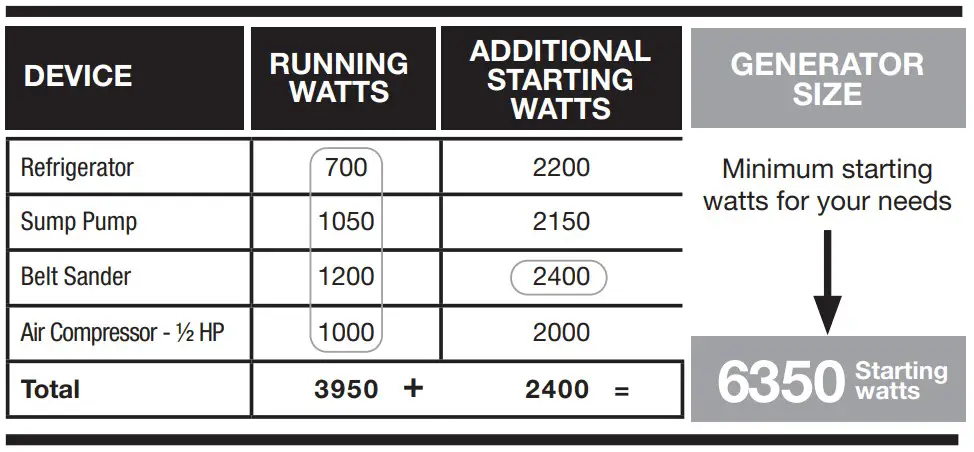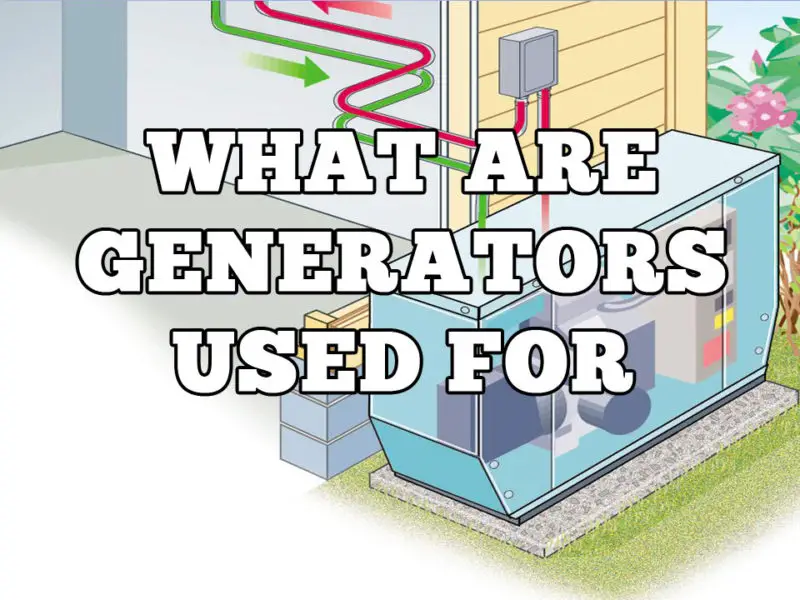When it comes to generators, size matters a lot. A generator too big for the application can lead to power wastage, thus unnecessary expenses. Meanwhile, a generator too small for the application may fail to power all your appliances and devices.
For the above reasons, you must determine the correct size generator based on the task at hand. The following is a 3-step guide to help you pick just the right size.
1. Calculate your load size
The first thing that you should have in mind is why you’re buying the generator in the first place. Where will you use it, and which appliances and devices will it power once you bring it home?
The only way to find out is to list everything you plan to power with your generator. This varies widely from one user to another and one home to the next.

For instance, if shopping for whole-home generators, two users may need completely different generator sizes if they have different home sizes. The user with a larger home will need a bigger generator. Two users may also need different generator sizes based on appliance sizes. A bigger refrigerator, for instance, draws more power.
Another critical factor is the number of appliances. You need a larger generator to power more appliances. For instance, if you desire a backup generator to power your computer systems during a blackout, the ideal size will directly depend on the number of computer devices.
The following is a summary of typical power ratings for common electricity-powered equipment and appliances.
| RECREATION & CAMPING | ESTIMATED RUNNING WATTS | ADDITIONAL STARTING WATTS |
|---|---|---|
| AM/FM Radio | 100 | – |
| Box Fan | 100 | – |
| Cell Phone Battery Charger | 25 | – |
| Inflator Pump | 50 | 150 |
| RV Air Conditioner (13,500 BTU) | 700 | 1500 |
| GENERAL PURPOSE & EMERGENCY BACKUP | ESTIMATED RUNNING WATTS | ADDITIONAL STARTING WATTS |
|---|---|---|
| Coffee Maker | 1000 | – |
| Computer with a 17″ Monitor | 800 | – |
| Microwave – 1000 Watts | 1000 | – |
| Refrigerator/Freezer | 700 | 2200 |
| Sump Pump ½ HP | 1050 | 2150 |
| Television – 27″ | 500 | – |
| Space Heater | 1800 | – |
| Window AC – 12,000 BTU | 3250 | 3950 |
| Humidifier | 175 | – |
| JOBSITE & CONSTRUCTION | ESTIMATED RUNNING WATTS | ADDITIONAL STARTING WATTS |
|---|---|---|
| Air Compressor – 1 HP | 1400 | 3600 |
| Airless Paint Sprayer – 1/3 HP | 600 | 1200 |
| Belt Sander – 3″ | 1200 | 2400 |
| Bench Grinder – 8″ | 1400 | 1100 |
| Circular Saw – 7-¼” | 1400 | 2300 |
| Hand Drill – ½” | 600 | 900 |
| Miter Saw – 10″ | 1800 | 3300 |
| Quartz Halogen Work Light | 1000 | – |
| Reciprocating Saw | 960 | – |
| Table Saw, 10″ | 2000 | 2000 |
The total wattage will tell you the amount of electrical power needed, and from there, you can work out the minimum electrical input required from a generator. Fortunately, you can get appliance wattage information from the equipment’s nameplate or the manufacturer’s guide.

3950 Running Watts and 6350 Starting Watts.
On the same note, keep in mind that electrical appliances may have different starting and running wattage requirements. Typically, it takes more energy to start motor-powered equipment than to run the motor.
Make sure to factor in the initial surge when sizing the generator. Otherwise, your generator might fail to jumpstart your systems.
2. Converting kilowatts to kilovolt-amperes
When you sum up the maximum required wattage for your equipment, you will end up with the total sum in kilowatts. This is the actual power the load needs to produce a useful working output.
However, generators are rated in kilo-volt-amperes, not kilowatts. A kilovolt-ampere is the measure of apparent power which means the total amount of power in use in a system.
In an efficient system, 1kW=1kVa. But, unfortunately, no system is 100% efficient. Therefore, not all the system’s apparent power goes into producing useful work output.
For this reason, you need to convert kilowatts to kilovolt-amperes depending on the efficiency of the electrical system. Electrical efficiency is expressed as a power factor ranging from 0 to 1. The closer the power factor to 1, the more efficient the system.
The power factor is crucial for matching the size of your load to a generator. For instance, a generator rated at 100kVa and a 0.8 power factor will be too small to power a device that requires 100KW of actual power. Instead, the device would need at least 100/0.8 = 125KVA.
Choosing the proper generator size is easy once you have a rough estimate of the required power in kilovolt amperes. Just make sure to go for a generator with some allowance. This will give you some space for adding an appliance or two in the future. It also helps manage occasional underperformance due to adverse operating conditions, such as extreme temperatures, high altitudes, and dusty environments.
3. Running requirements
Finally, you should also choose the size based on running requirements. For instance, consider whether the generator will be the primary source of power or not. This is very important since you don’t want a generator running continuously at maximum capacity for more than 30 hours.
Therefore, if you will use it as your primary power source, buy a 70%-80% bigger capacity. Also, leave a small margin for safety precaution and performance challenges.
Another important consideration is whether the generator has multiple motors and how many motors you intend to engage at a time. For example, if you intend to engage two or more motors on the same generator, you can do with a smaller size.
Lastly, some generators can be paralleled to create a bigger power source. Generator paralleling means connecting two or more generators in parallel. Doing so enables you to create a more potent power source from smaller-sized generators, meaning you can pick several smaller generators even for a major application.
Whole-House Energy Monitoring Systems
If you want more detailed data on your home’s energy use (as well as the ability to measure the energy use of 240-volt appliances), you might consider installing a whole-house energy monitoring system. The features of these systems vary, and the cost and complexity depends on the number of circuits you want to monitor, the level of detail of the data, and the features available. The monitor can be as simple as a “plug load” monitor that plugs into an outlet; then you plug the device/appliance into the monitor. Typically, an LED screen displays the consumption.
Here are some recommended products to monitor your energy use:
Summary
Hopefully, you now know how to pick the right power generator for your next application. Contact us if you need further guidance.






